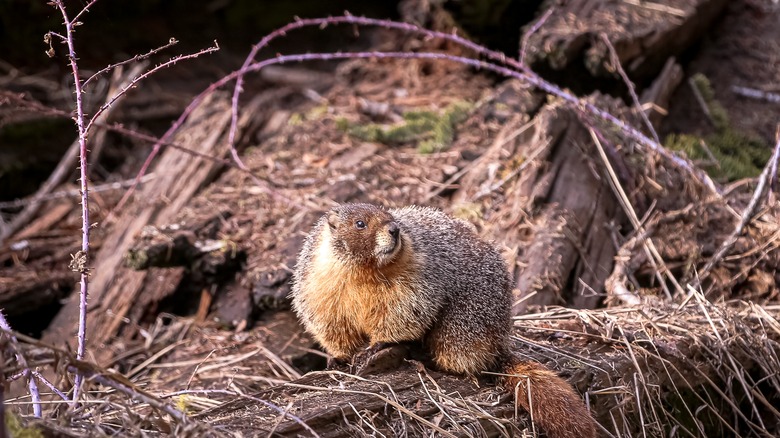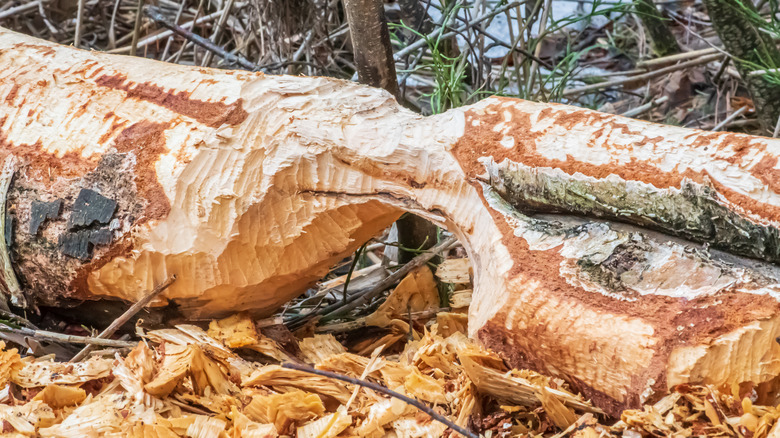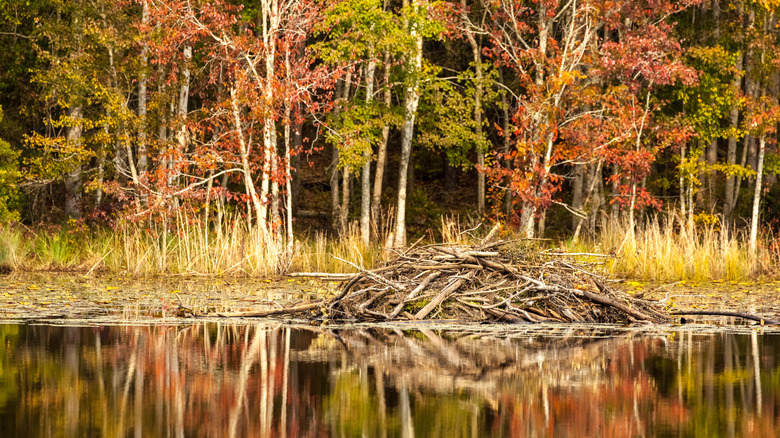The Telltale Sign That A Beaver Den Is Nearby
Patient, resilient, and resourceful, beavers are nature's engineers as they work tirelessly to design and build their waterway homes that provide them with shelter and a place to store their food. Instinctively drawn to the sound of running water, the dams they build become wider and taller as they work to stop the water flow. The urgency of this goal drives them to collect as many materials as possible from the surrounding river bank and forest to seal these structures, including tree bark, leaves, grass, or branches. This mission explains why the most obvious indication of a nearby beaver den is when the trees near a pond have been stripped bare and show fresh chewing marks.
One of the reasons that beavers leave such a profound impact on nearby vegetation is because they are herbivores and eat only plants. Their diet consists of the same materials that they use to build their homes. They will strip the soft bark from the branches of their favorite trees, such as willow, aspen, birch, and maple trees, to line the nests in their dens as well as to store for food. They also love to eat the leaves of these trees as well as the aquatic vegetation that borders the water. Then they will chew through branches and logs in order to build their shelter. All of this activity in the nearby vegetation leaves an unquestionable indication that beavers have been busy nearby.
Evidence of beaver activity
As beavers carry branches and logs into the water, they leave more confirmation of their presence in the mud and banks of the pond. As they drag the foliage back to their shelter, they create trails through the brush where it has swept through. A significant characteristic of these trails is how they extend down the bank and into the water. While many of their footprints are swept over by their tails or the tree branches, they can occasionally be seen in the mud by the water. They have five toes on each foot with webbed hind feet, making them excellent swimmers with distinctive footprints.
Beavers are nocturnal animals, so it's not uncommon to discover that these clues to their presence have appeared overnight. Industrious as they are, they will work methodically to build their dam and create the watery refuge they need, especially as they prepare for winter. Their dams are often built by jamming branches into the mud of the river, and then they fill up the crevices with rocks and mud. The entrance to their home is always a few feet under the surface of the water, and an opening leads to a den inside. Positioning the entrance to their home underwater keeps them safe from predators, While beavers are excellent swimmers and can stay underwater for as long as 15 minutes, their living spaces inside the den are above the water level.
Protecting their dens
Because beavers are busy at night and fairly quiet as they go about their work, the sounds of their activity is not what alerts anyone that they're nearby. The one exception, however, is when they use their tail to send a warning to intruders. A beaver's tail is wide and flat, perfect for maneuvering underwater. It also works well as a paddle that can be slapped on the water's surface if the animal feels threatened. The loud sound of this slap is an unmistakable indication that a beaver's den is close by and is actively being defended.
While bare trees are a sure indicator of a beaver's presence, other signs provide clues that a beaver is at work. In search of the right materials for a den, a beaver may extend beyond the forest and "borrow" materials nearby, such as the wood pile in a neighbor's yard. Gnaw marks on the logs are signs that the beaver is looking to reinforce its den by gathering as much wood as possible. Evidence of beaver activity can also appear inside a drainage culvert that is built under a road. In its earnest desire to block any running water, the animal will fill the culvert with mud and sticks, which will often cause the water to rise and flood the road above it. The beaver's instinct to use natural materials to alter its environment is why It lives up to its reputation as nature's engineer.


